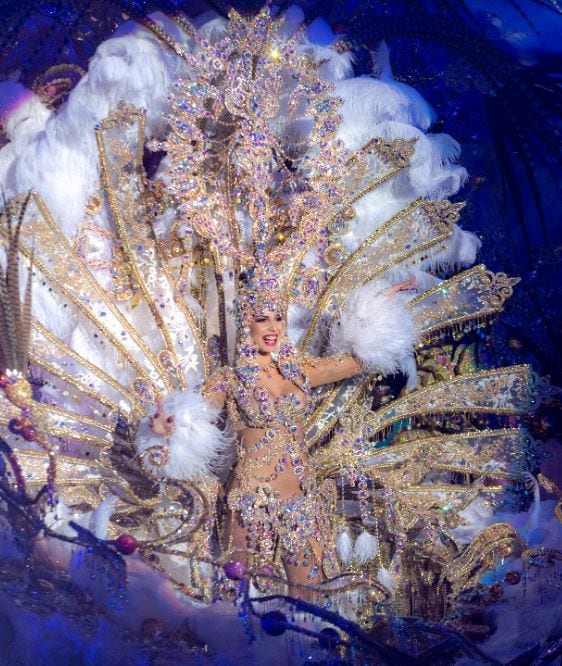18th December 2019
The Carnival of Santa Cruz de Tenerife starts on 24th January 2020. It’s the most important carnival in Europe and the second most important in the world (top-billing goes to Rio de Janeiro, Santa Cruz de Tenerife’s sister city).
Hundreds of thousands of people will congregate in the Canary Islands from 24th January until 1st March to celebrate the Santa Cruz de Tenerife Carnival, the most important carnival in Europe and the second most important in the world. In 1987, 250,00 people took to the streets to dance to the music of Celia Cruz and, in the process, beat the Guinness world record. Since then visitor numbers have continued to increase. For example, in 2019, 400,000 people gathered on Piñata Saturday, the most important day of the carnival.
The celebrations consist of two distinct parts: The Official Carnival and The Street Carnival. The Official Carnival is made up of more than 100 designated groups, each composed of, on average, 50 parts. There can be strange bands clothed in fancy dress, troupes of dancers, actors and singers, street musicians, stringed ensembles and other musical groups. In total more than 5,000 people flood the streets in a spectacle of light, sound and colour. Alternatively, The Street Carnival – declared a ‘Fiesta of International Tourist Interest’ by the Spanish Ministry of Tourism in 1980 – is open entry: anyone can dress up, dance and participate.
Crowning of the Queen
One of the most important events is the Carnival Queen Election Gala. On 24th January dozens of competitors in various categories flaunt their wares in costumes that have been carefully tailored over many months. In some cases, outfits have been valued at tens of thousands of euros.

In many workshops in Santa Cruz de Tenerife, craftsmen work long hours in search of an authentic carnival costume. Santi Castro, president of the Association of Carnival Designers, believes that to understand the carnival it is essential to “spend a few hours in an artisan’s workshop, to see the Queen live from the inside, get to know her guts…it’s pure passion.” Castro should know; he has been designing carnival queen costumes for 40 years.
Besides fabrics, all kinds of materials – including plastic, cardboard, aluminium, sequins and acrylic stones – are arranged on a large metal structure to make the outfits. With final products that can weigh up to 500 kilos and require wheels, enormous costumes are one of the characteristics of the carnival. Demand for ever larger outfits is such that organisers have put a dress size safety limit of 5 x 4.3 x 6 metres.
Songs with social and political criticism
Masi Carvajal, the director of one of the murgas called Diablos Locos, says that “the best thing to do is to see the whole carnival all the way down to the day-to-day contests of the street performers. That way you get to see the whole range.”
Murgas are groups of song writers who sing songs through the carnival streets. They compete with one another for prizes and their lyrics cover subjects that include socio-economic problems, corruption, gender inequality and gender-based violence.
Music includes comparsas, groups of musicians and dancers which resemble the samba schools of the Rio carnival. Tenerife’s first comparsa was created in the sixties by Manuel Monzón, and today the troupes – of various distinctly arranged styles – form an integral part of the festivities.
José Manuel González, the director of Cariocas, one of the oldest comparsas on the island, states “the Rhythm and Harmony Parade along Anaga Avenue is really something to experience. It’s amazing.”
Other Carnivals in the Canary Islands
- Since 1998 Las Palmas de Gran Canaria has held the internationally renown Drag Gala. The show, which loves to shock, sees men transformed into ostentatiously dressed women as they perform competing dance routines on jam-packed platforms raised high into the sky.
- A highly recommended event is the Carnival de Los Indianos in Santa Cruz de La Palma. It has been running for over 50 years and celebrates the triumphant return of the newly wealthy Canary islanders who travelled to the Americas. Sosó reprises his celebrated role of Negra Tomasa in this strange and original party. The city’s main square is converted into a piece of Cuba and, for decoration, talcum powder is sprinkled over everyone.
- San Sebastián de La Gomera offers an alternative to the queens’ galas or the Festival of the Murgas in the capital. The Carnival of Talcum Powder is a day of disguise. All who participate use talcum power, flour or even indigo pigment to conceal themselves.
- Tigaday, a town on the island of El Hierro, celebrates Los Carneros. The festival springs from a tradition that was about to disappear when it was rediscovered by the young people of the area. In a terrifying spectacle, youths disguise themselves with foul smelling dried rams skins and run after the public ready to throw black dye over anyone that is too slow to get out of their way.
- Having been practiced for more than five centuries, the Diabletes de Teguise in Lanzarote is one of the Canary Island’s oldest festivals. Participants scare anyone who crosses their path with costumes that derive from traditional symbols: a horned ox’s head, a goat’s tongue and a shepherd’s bag.
- Carnivals are played out on land but also at sea. In Fuerteventura, the arretrancos and achipencos festivals are great fun. Crazy vehicles move from dry land to water.
ENDS
https://www.hellocanaryislands.com/
Access the images used in this press release by clicking here.
For more information on the Canary Islands, please email niamh@travelmedia.ie

